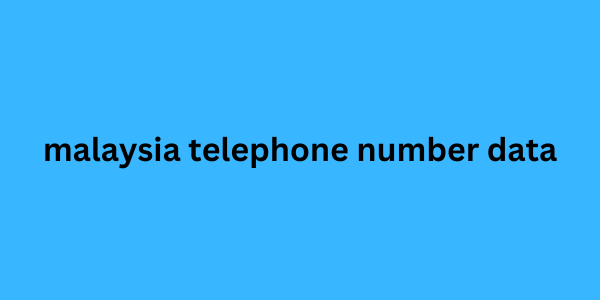In this article, we’ll cover the basics of UML class diagrams, including what they are, why you should use them, and how to create your own.
What are class diagrams?
Class diagrams are static structure diagrams that visualize and malaysia telephone number data model object-oriented systems.
In object-oriented programming (OOP), a class is a template or blueprint that is used to create some kind of object. When a bunch of objects have the same structure or common behaviors, you can assign them to a class. The class can then be used to create any number of objects that share the same structure and behaviors.
For example, you might have a class called UserAccount that you use to create a user account object for your website. This class might include a set of attributes that all user account objects created from it must have, such as first and last name, email address, phone number, birth date, etc. While the structure and attributes are the same for each object, the values for each attribute field will be different and make each user account object unique.
It’s sort of like owning a car. You buy a specific make and model with the features that you want. These cars are mass-produced in factories using a specific blueprint, or class, that specifies the structure and standard features. This means there are probably thousands of cars just like yours on the road. They are all objects created from the same class. They share the same structure, features, and behaviors but might vary in little things such as exterior and interior colors.
So a class diagram is simply a visual representation of classes you’ve defined. The diagrams describe class structure, attributes, specifications, and behaviors, as well as the relationships among various classes. They help you to visualize and understand different aspects of complex software systems.
Understanding Unified Modeling Language
Class diagrams are created using Unified Modeling Language (UML). UML is a common, standardized graphical language that lets you visualize software systems. It is used in OOP to help developers to create consistent, structured architecture. The UML notation includes a library of integrated diagrams that you can use to represent the objects and processes that make up a piece of software or software systems.
A class diagram is one of several different types of UML diagrams. There are two broad categories: structural UML and behavioral UML. Class diagrams fall under the structural UML category. They are static structure diagrams that you can use to describe a system’s structure.
Using UML notation, you can create a visualization that describes and documents your system’s classes, their attributes, operations (or methods), and the relationships among the objects. UML class diagrams also help developers to describe and present systems in a way that is easier for everybody involved in the project to understand.
Benefits of using UML class diagrams
The biggest benefit of class diagrams might be that they let you visualize systems. Presenting complex ideas in visual form is important because our brains can process images faster than other types of information.
Additionally, class diagrams are one of the main building blocks in object-oriented modeling. They are the only UML diagrams that can be mapped directly to OOP languages such as Python, Java, and C++. This makes them one of the most popular UML diagrams among software developers because they are helpful during software construction.

You should use UML class diagrams so you can:
Help developers to think about class structure and interactions before writing any code. This can lead to cleaner and better functioning software.
Draw detailed charts and document requirements that need to be included in the code.
Share information with stakeholders more easily with visual presentations without diving into the code.
Illustrate data models for any system no matter how complex.
Easily share information throughout your business.
Have a better understanding of the general schematics of an application.
Document requirements and other aspects of a system without complicated, text-heavy explanations.
Business analysts can use class diagrams to create models from a business perspective.
class diagrams
UML class diagram example (click on image to modify online)
How to create class diagrams
Before you jump in and start drawing class diagrams, get familiar with UML shapes and the basic elements.
The class shape itself is a rectangle divided into three sections:
Upper section: This section is required because this is where you name the class. The class name should:
